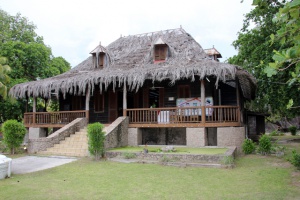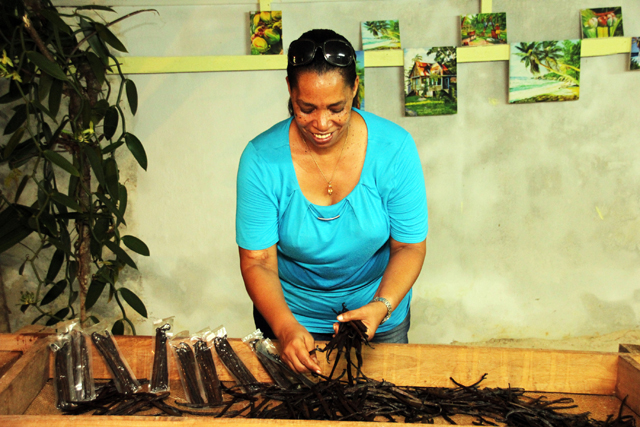Preserving an island's culture and history - Seychelles' traditional plantation house transforming into museum
Arts & Culture |Author: Sharon Meriton-Jean | October 12, 2014, Sunday @ 17:05| 11160 views
The old plantation house (Grann Kaz) that will be restored and turned into a museum for La Digue. (Romano Laurence, Seychelles News Agency)
(Seychelles News Agency) - A place for the Seychelles third most populated island of La Digue to showcase its cultural and historical identity to its visitors – that is the aim of plans to turn the old and unused plantation house on the island into a museum.
The traditional plantation house, known in Creole as the “Grann Kaz” which is the most iconic building at L’Union Estate, is currently standing unused in the middle of the property which spreads over some 300 hectares of land, owned by the Seychelles government.
Plans are now well underway to restore the old traditional planter’s house, which is a national monument, to its original architecture and give it a purpose.
It was on the occasion of the 30th anniversary of the setting up of the estate, that the company currently responsible of managing and running the property, L’Union Estate Pty Ltd signed a memorandum of understanding with the Seychelles Heritage Foundation to formalize plans to turn the empty building into a museum.
“Following this agreement, we will start collecting information and artefacts from the people of La Digue so as to have a very informative and interesting museum by next year,” said Patrick Nanty, the Chairman of the Seychelles Heritage Foundation, after signing the agreement.
|
|
| Patrick Nanty, the Chairman of the Seychelles Heritage Foundation signing the agreement to finalize plans to turn the "Grann Kaz" into a museum with the Chairman of the L’Union Estate Board, Ronald Cafrine. (Romano Laurence, Seychelles News Agency) Photo License: CC-BY |
The Seychelles Heritage Foundation is mandated to ensure the preservation and protection of cultural and historical sites of Seychelles.
L’Union Estate on La Digue is one of such sites that the foundation is now seeking to preserve so that the around three thousand residents of the island can derive maximum benefits from it.
The breadwinner for La Digue
Apart from its natural beauty, the property is also of important cultural and historical value to the residents.
Greeting visitors at the entrance is an old cemetery which is the final resting place of some of the very first settlers on the island including the Mellon family which arrived there in the early 1800’s.
|
|
| The old cemetery at L'Union Estate. (Romano Laurence, Seychelles News Agency) Photo License: CC-BY |
Apart from the ‘Grann Kaz’, L’Union Estate also has several old buildings including a copra production house (copra is the dried meat, or kernel, of the coconut used to extract coconut oil) as well as a running coconut oil mill which is supplied by the hundreds of coconut trees that grows on the estate.
|
|
| Coconut oil produced at L'Union Estate on La Digue. (Romano Laurence, Seychelles News Agency) Photo License: CC-BY |
In the shade of impressive granite boulders believed to be millions of years old are also several giant Seychelles tortoises, that serve as an attraction to the hundreds of visitors that pass by as they head to one of the most popular beaches on the island, Anse Source D’Argent.
|
|
| The tortoise enclosure is a popular attraction. (Romano Laurence, Seychelles News Agency) Photo License: CC-BY |
The Anse Source D’Argent beach was recently voted amongst the top 12 Beaches with Crystal Clear water by the travel website, TripAdvisor and as the most beautiful beach in the world by the national Geographic’s coffee-table book, the 10 Best of Everything.
Access to the beach is only through the entrance of L’Union Estate where visitors have to pay a fee of $7.5.
|
|
| The crystal clear water at Anse Source D'Argent on Seychelles third most populated island of La Digue (Gerard Larose, Seychelles Tourism Board) Photo License: CC-BY |
According to the management company, an important number of tourists, more than 600, go through the estate every month. The museum along with other innovative projects being envisaged are therefore aimed at increasing the earnings of L’Union Estate.
A new board was appointed to manage the property at the end of 2012. They were given the task to tap into the vast potential of the estate so that it can yield higher returns after several irregularities including financial ones were detected through an audit.
“We want to venture into eco-tourism and we have the perfect sight for it,” the Chairman of the L’Union Estate Board, Ronald Cafrine told SNA.
“With this in mind, part of the estate will soon be leased to the best bidder in order to undertake agricultural and livestock farming.”
Only 10 hectares of land will be leased to the private sector through this initiative.
For three centuries the estate has been the main area for livestock farming such as pigs and chicken as well as the main supplier of vegetables and fruits for the residents on La Digue as well as its visitors which the island is heavily dependent on.
“We supply to all the hotels and businesses and what is left we sell to the community,” Keddy Nibourette, the Chief Executive Officer of L’Union Estate, told SNA adding that at times there is even enough to sell to other Seychelles islands.
The estate has over sixty workers engaged in the various economic activities.
30 years of historical importance
As new ventures are put in place, plans to preserve the historical aspects of L’Union Estate will surely mean that visitors will get to know more about past activities that once played an important role in attracting visitors to La Digue and brought in revenue for the islanders.
This includes the horse stables, the boat building activities and the once important vanilla plantation. Although production has decreased, the vanilla plantation remains an attraction for the visitors.
|
|
| L'Union Estate also has a vanilla plantation. (Romano Laurence, Seychelles News Agency) Photo License: CC-BY |
The management of L’Union Estate and the Seychelles Heritage Foundation are also hoping to start bidding for the property to get international recognition as a world heritage site.
With both the granite boulders and the plantation house being declared national monuments, L’Union Estate “has all and more of the requirements to bid for the international title,” said the chairman of the Seychelles Heritage Foundation, Patrick Nanty.
“It will be justifiable for this property to make such a claim, as I think that there this is not only a cultural and historical sight but it has also a natural beauty that is not comparable to any other sites.”
Currently, Seychelles with a small population of 90,000 people has two UNESCO world heritage sites.
They are the Aldabra atoll home to some 150 thousand Aldabra giant tortoises and Vallee de Mai on the second most populated island of Praslin where grows the largest nut in the world, the Coco de Mer.
Back






